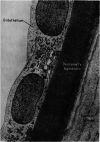Corneal endothelium: developmental strategies for regeneration
- PMID: 23470788
- PMCID: PMC3650267
- DOI: 10.1038/eye.2013.15
Corneal endothelium: developmental strategies for regeneration
Abstract
The main treatment available for restoration of the corneal endothelium is keratoplasty. This procedure is faced with several difficulties, including the shortage of donor tissue, post-surgical complications associated with the use of drugs to prevent immune rejection, and a significant increase in the occurrence of glaucoma. Recently, surgical procedures such as Descemet's stripping endothelial keratoplasty have focused on the transplant of corneal endothelium, yielding better visual results but still facing the need for donor tissue. The emergent strategies in the field of cell biology and tissue cultivation of corneal endothelial cells aim at the production of transplantable endothelial cell sheets. Cell therapy focuses on the culture of corneal endothelial cells retrieved from the donor, in the donor's cornea, followed by transplantation into the recipient. Recently, research has focused on overcoming the challenge of harvesting human corneal endothelial cells and the generation of new biomembranes to be used as cell scaffolds in surgical procedures. The use of corneal endothelial precursors from the peripheral cornea has also demonstrated to be effective and represents a valuable tool for reducing the risk of rejection in allogeneic transplants. Several animal model reports also support the use of adult stem cells as therapy for corneal diseases. Current results represent important progresses in the development of new strategies based on alternative sources of tissue for the treatment of corneal endotheliopathies. Different databases were used to search literature: PubMed, Google Books, MD Consult, Google Scholar, Gene Cards, and NCBI Books. The main search terms used were: 'cornea AND embryology AND transcription factors', 'human endothelial keratoplasty AND risk factors', '(cornea OR corneal) AND (endothelium OR endothelial) AND cell culture', 'mesenchymal stem cells AND cell therapy', 'mesenchymal stem cells AND cornea', and 'stem cells AND (cornea OR corneal) AND (endothelial OR endothelium)'.
Figures



References
-
- DelMonte DW, Kim T. Anatomy and physiology of the cornea. J Cataract Refract Surg. 2011;37 (3:588–598. - PubMed
-
- Krachmer H, Manis J, Holland J.Cornea: Fundamentals, Diagnosis and Management2nd edn.Elsevier Mosby: Beijing, China; 2005
-
- Bonanno JA. Identity and regulation of ion transport mechanisms in the corneal endothelium. Prog Retin Eye Res. 2003;22 (1:69–94. - PubMed
-
- Joyce NC, Harris DL, Mello DM. Mechanisms of mitotic inhibition in corneal endothelium: contact inhibition and TGF-beta2. Invest Ophthalmol Vis Sci. 2002;43 (7:2152–2159. - PubMed
-
- Mehta D, Malik AB. Signaling mechanisms regulating endothelial permeability. Physiol Rev. 2006;86 (1:279–367. - PubMed
Publication types
MeSH terms
LinkOut - more resources
Full Text Sources
Other Literature Sources
Medical

